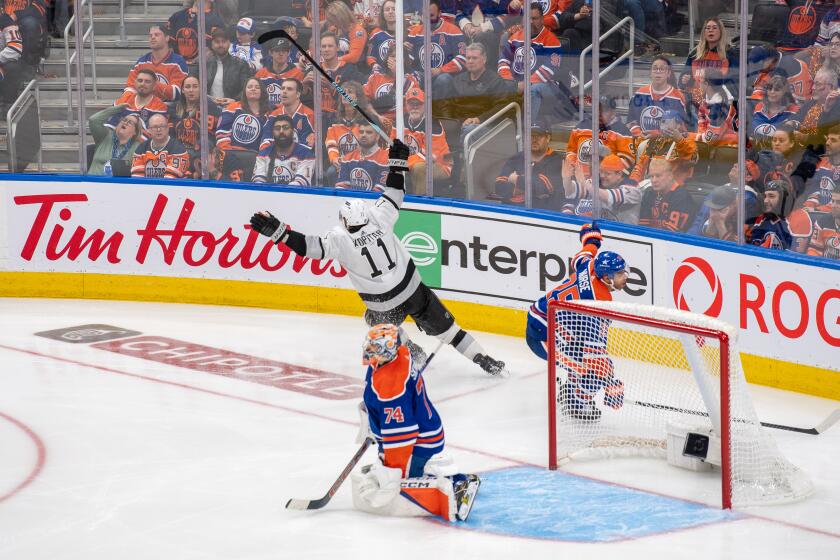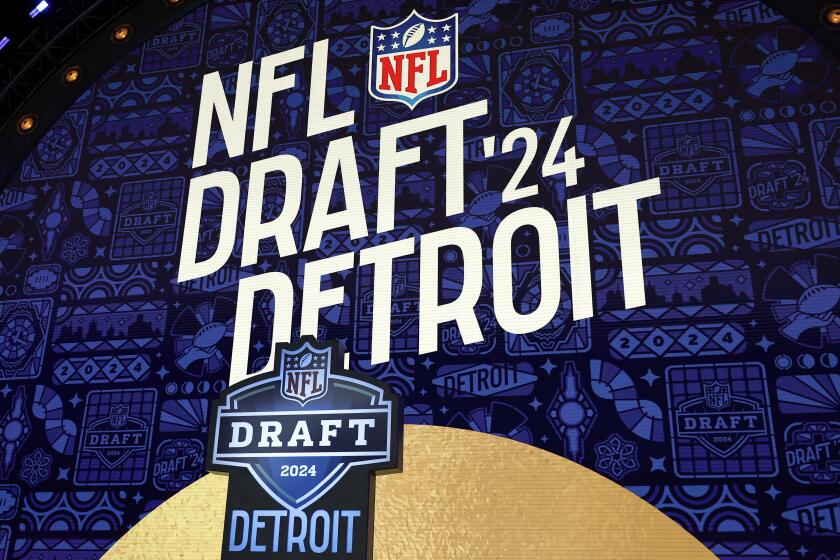Ray “Windmill” White left his mark on boxing -- from behind
From Oak View, Calif.
Ray “Windmill” White, a veteran of 60 professional fights, pulls a paperback from a shelf in his office, opens “The Ultimate Book of Boxing Lists” and thumbs through it.
Finally spotting his name, he looks up and smiles.
“So,” the 72-year-old proudly announces to a visitor, “out of all the fighters that ever lived, I made the top 10.”
Page 88 confirms it.
White, a 6-foot-4 former light-heavyweight best known for throwing behind-the-back punches and other unorthodox blows, has been deemed by authors Bert Sugar and Teddy Atlas the fifth most-awkward fighter in boxing history.
It might seem an undesirable designation, but to the unabashed White it confirms that he at least left a mark.
So does this: White, still involved in boxing as an instructor, will be inducted next month into the Ventura County Sports Hall of Fame and the California Boxing Hall of Fame.
He was not a great fighter, never fighting for a world title, but the Ventura-based carpenter reigned for years as the state light-heavyweight champion. And, thanks in part to frequent appearances on Channel 5 boxing shows that were packaged for airing throughout the United States, White was a wildly popular gate attraction whose in-ring antics during his late 1960s and early ‘70s heyday enthralled fans as often as they infuriated opponents.
“People loved him,” says Don Fraser, president of the California Boxing Hall of Fame. “You never knew what he was going to do next. He was always coming up with something different.”
Not all, however, were impressed.
Times columnist Jim Murray scoffed that White’s behind-the-back punch was “guaranteed to stun a fly,” adding that the boxer’s “only real chance of winning” was to “go in the ring with a contagious disease.”
Clay Hodges, who as an amateur twice defeated George Foreman, told Ring magazine that White’s “crackpot antics” made boxing “a laughable spoof on the level of professional wrestling” and called him “an embarrassment to the sport.”
If the critiques sting White, he doesn’t let on during an interview at his home office in the picturesque Ojai Valley.
“I wish I could tell you something about chasing glory and that I had a dream and all that,” he says, “but I was just going with the flow and having fun. This was a big fun ride for me.
“I didn’t want to be Joe Louis or anything. I was just having a party and that was bad, I guess. That’s why they figured I was just a clown and I wasn’t good for boxing. Very likely I wasn’t, but I was popular and if you’re not popular, you don’t get fights.”
White says he was a serious boxer — “I had to be in better shape than my opponents,” he notes, “and I always was” — and took to clowning in the ring almost by accident.
A military brat born in Rochelle, Ga., and introduced to boxing as a picked-upon teenager in Monroe, La., he developed his array of unusual punches to “frustrate guys” and win fights.
When they also made him popular, that was all the better.
In one of his earliest fights, he says, “a guy grabbed me around the waist and wouldn’t let go,” so White proceeded to pummel him in the kidneys with both hands simultaneously. “The writers,” notes White, “said it looked like a rooster flapping its wings.”
Thus was born the “rooster punch,” part of a collection that would grow to include, among many others, the “Wilt Chamberlain Dunk Punch,” which involved White jumping and taking a downward swing at a foe, and the behind-the-back punch, which one writer dubbed “The Shot from Behind the Tree.”
Other improvisations included “The Double Uppercut,” “The Double-Whammy Jab” and other comical tactics.
White’s clowning really came to the fore in November 1967, when he fought George “Scrap Iron” Johnson in San Diego.
Though seven inches shorter, the compact Johnson outweighed the 187-pound White by 30 pounds and had gone the distance against Joe Frazier only six months earlier.
White, battered by Johnson and convinced that he was in over his head, says he resorted to throwing his burlesque punches in an effort to get the referee to stop the fight.
“But he tells me, ‘The crowd loves it,’ ” White says.
Less enthused was Johnson, who stopped methodically tattooing White in favor of trying to level him with a haymaker.
Clowning, White realized, could be a workable strategy.
Though he lost a 10-round decision, White made it to the final bell against Johnson and proved his mettle. In 1974, after twice losing close decisions with world championship fights on the line, he retired with an overall record of 41-14-5.
A single parent of two sons and two daughters, he returned to carpentry but never lost his love for entertaining.
As part of a clogging dance troupe, White has performed at Magic Mountain, Knott’s Berry Farm and Disneyland as well as in Florida, North Carolina and Chicago.
“I just did it last night,” he says. “I’m sore as the Dickens.”
Now retired and a great-grandfather, he works with young amateur fighters at the KO Boxing Club in Ventura.
So far, none has asked to learn his signature punches.
“That’s all instinct,” he says.
More to Read
Get our high school sports newsletter
Prep Rally is devoted to the SoCal high school sports experience, bringing you scores, stories and a behind-the-scenes look at what makes prep sports so popular.
You may occasionally receive promotional content from the Los Angeles Times.






